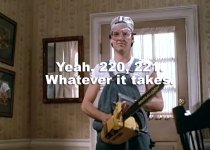etpm
Veteran Member
- Joined
- Jun 30, 2021
- Messages
- 2,341
- Location
- Whidbey Island, WA
- Tractor
- Yanmar YM2310, Honda H5013, Case 580 CK, Ford 9N
When I wired in my generator sub panel last year I transferred all the circuits I thought I would need. If all the amps are added they exceed by quite a bit the amps my 7500 watt generator will put out. But I have never loaded up the circuits to their breaker rating. I am thinking about buying a 4000 watt generator. My only worry is starting the well if the fridge and freezer are also starting. I think I can get some sort of load sensing device that will prevent the well from starting if the load is too high. Though it may be possible to obviate using this device by using capacitors. The well motor is already a capacitor start motor, or maybe the cap is always in circuit. But I think it's a cap start. Anyway, I remember reading about a scheme used in industrial settings for starting motors when other motors were starting and there was a consequent voltage drop. Capacitors were used as well as relays. I think. It was really a kind of brute force setup the sort of which was common in the mid twentieth century. if anybody reading this has any info I would be happy if they posted it.
Thanks,
Eric
Thanks,
Eric
